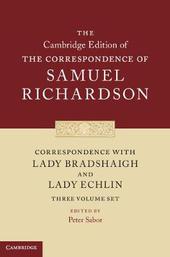
|
Correspondence with Lady Bradshaigh and Lady Echlin 3 Volume Hardback Set (Series Numbers 5-7)
Hardback
Main Details
Description
Samuel Richardson (1689-1761), renowned English novelist and master printer, was also a prolific letter writer. The Cambridge Edition of the Correspondence of Samuel Richardson is the first complete edition of his letters. These three volumes contain his correspondence, much of it published for the first time, with two fascinating women: Dorothy, Lady Bradshaigh (1705-85) and her sister Elizabeth, Lady Echlin (1704-82). Lady Bradshaigh was Richardson's most prolific and important correspondent, challenging him about a range of issues, literary and otherwise, including his intentions for Clarissa and Sir Charles Grandison, in an iconoclastic style. Lady Echlin lived in Ireland for much of her life and provided Richardson with information on Irish issues, including the Dublin editions of his novels. The scholarly apparatus in this volume furnishes a wealth of material about these women's lives and their milieu, affording many insights into eighteenth-century English and Irish social and literary history.
Author Biography
Peter Sabor is Director of the Burney Centre and Canada Research Chair in Eighteenth-Century Studies at McGill University. He is a past president of the Canadian Society for Eighteenth-Century Studies and a Fellow of the Royal Society of Canada. He is co-General Editor of The Cambridge Edition of the Works and Correspondence of Samuel Richardson, which is in progress. His many publications on Richardson include Pamela in the Marketplace: Literary Controversy and Print Culture in Eighteenth-Century Britain and Ireland, co-authored with Thomas Keymer (Cambridge, 2005).
Reviews'Thomas Keymer and Peter Sabor's magnificent 12-volume edition of the correspondence, three volumes of which, edited by Sabor, collect Richardson's letters with Bradshaigh. Their pages represent an extraordinary amount of work - in sorting through and piecing together the muddle of manuscript correspondence, handling Barbauld's editorial interventions, restoring obliterated passages, redating letters and decoding Bradshaigh's often eccentric spelling. The annotation is precise and sympathetic; the volumes are beautifully presented.' Clare Bucknell, The Times Literary Supplement
|